MSI A88XM-E35 Motherboard Review: Micro-A88X for $68
by Ian Cutress on April 3, 2014 11:59 AM ESTMSI A88XM-E35 BIOS
The MSI graphical BIOS has been a continual evolution for a couple of generations. Initially it started with putting games in the BIOS, and then moved to a sleeker display. While MSI was giving us a good amount of information, there were still a number of tweaks to be made. Users were not able to determine which part of the BIOS they were in from a screenshot, and there was no immediate help screen. Compiled on this, the overclocking options were a hodge-podge jumble with no structured order. I am glad to say that MSI has listened to its customers (or reviewers), and several of these adjustments have been made. I will point them out as we go through.
The first screen shown is the Main screen, with the persistent information bar along the top. This tells us lots of important info no matter where we are in the BIOS – the motherboard name, the motherboard BIOS version, the CPU installed, the speed of the CPU, the DRAM size and speed and the CPU temperature. This is about 85% of what I would like – something alongside CPU voltage and fan speeds might also be worthwhile.
MSI’s BIOS philosophy is to keep the tabs on the main screen constant and offer the change to different options in the middle. This is different to almost every other motherboard manufacturer – most tend to change most of the screen with every different tab.
Moving into the Settings tab gives most of the advanced options not related to overclocking. In this tab we see the right hand side change to a help menu, and as we move through the advanced menus, the central screen shows the location of where we are in the BIOS. I have wanted this change for over a year, so I am rather glad to see it!
The Advanced option in the Settings tab brings up the regular array of peripheral submenus as well as fast boot options for Windows 8 users. Users needing to change the LPT or COM settings will need to look in the Super IO Configuration menu, and storage settings should navigate to the Integrated Peripherals.
The overclocking menu is still is a mélange of options with a general order but nothing concrete to help users navigate better. It starts with the CPU options, followed by the memory and power adjustments.
One point users might immediately notice is the lack of voltage controls. MSI has decided to remove them from this motherboard. Given the nature of the motherboard (limited power delivery, price point) we could understand that MSI wants this motherboard to not be the focus of any overclocking performance testing. Nevertheless, users can adjust clock speeds, IGP frequencies and DRAM settings.
The cTDP option used for Kaveri APUs that have different thermal limit settings, such as the A8-7600, is found in the CPU Features sub-menu in the overclocking tab.
One of the features I remarked on in the last MSI Z87 review was the Hardware Monitor, offering a different take on fan controls. It appears here on the A88XM-E35, and allows users to adjust the points on the fan gradient and see a graphical representation of their adjustment. The BIOS states ‘fan speed’ but actually means ‘fan power’, and power is not directly proportional to speed. As noted in previous reviews, some fans will have a minimum speed up until a power %, or not enable until a power percentage %. This is still an inaccurate representation of the physics behind fans, but the graphical representation is a step in the right direction.
The final part of the BIOS is the Board Explorer, a feature now exhibited on several motherboard manufacturers’ products. It shows a top down image of the motherboard and several areas that the user can mouse over to see what is installed. This is useful for determining if a stick of memory is not working, or if a SATA device has come loose.


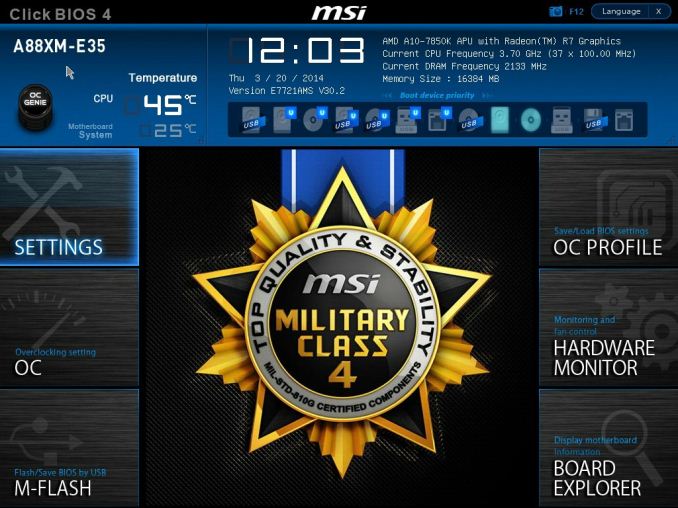
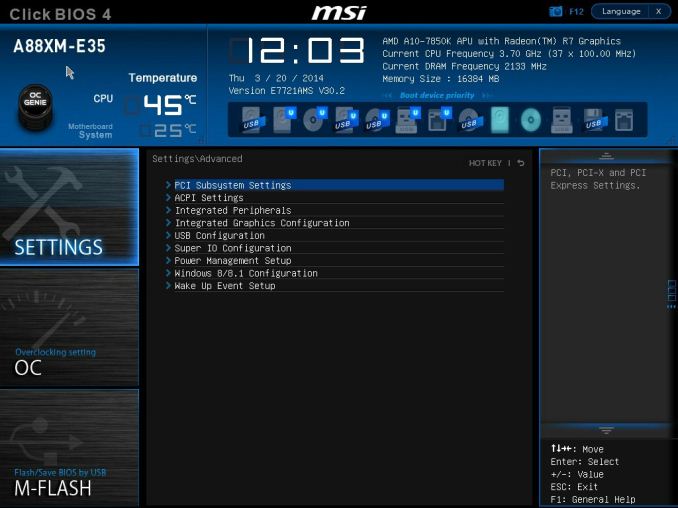

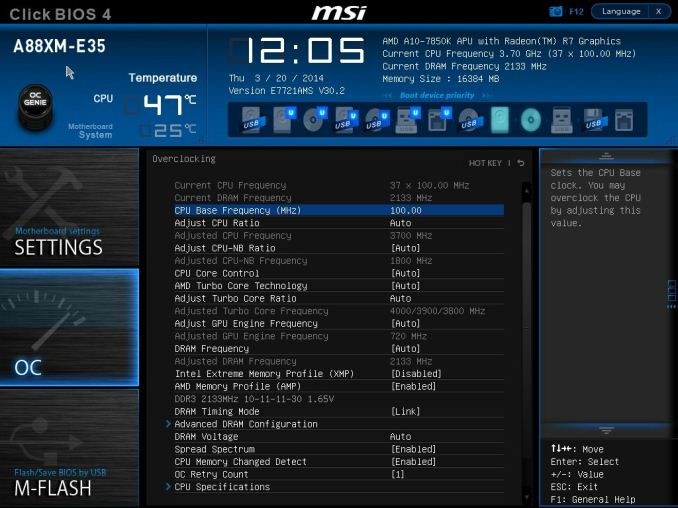
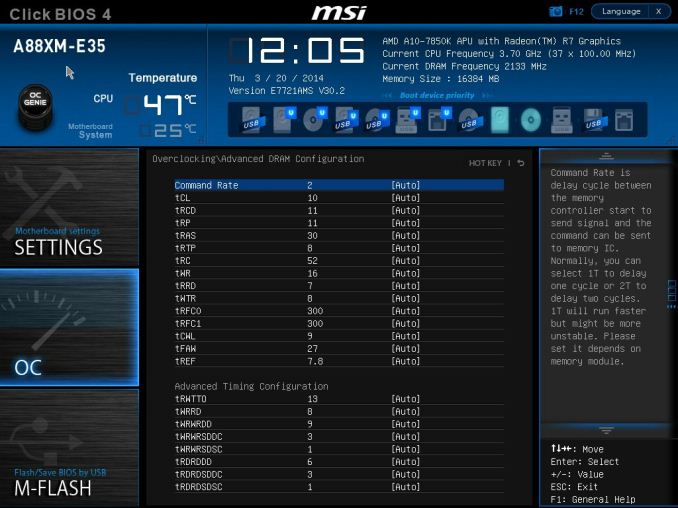
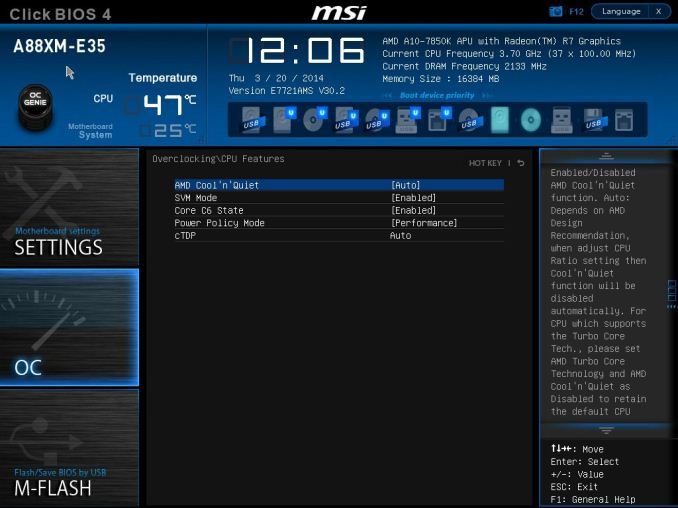
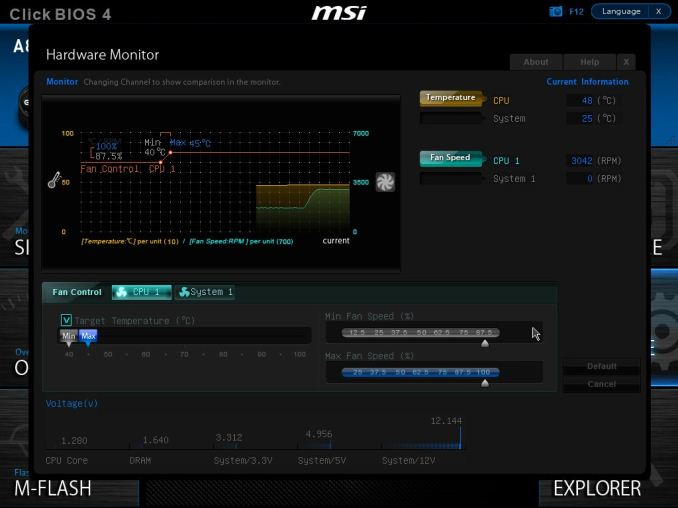
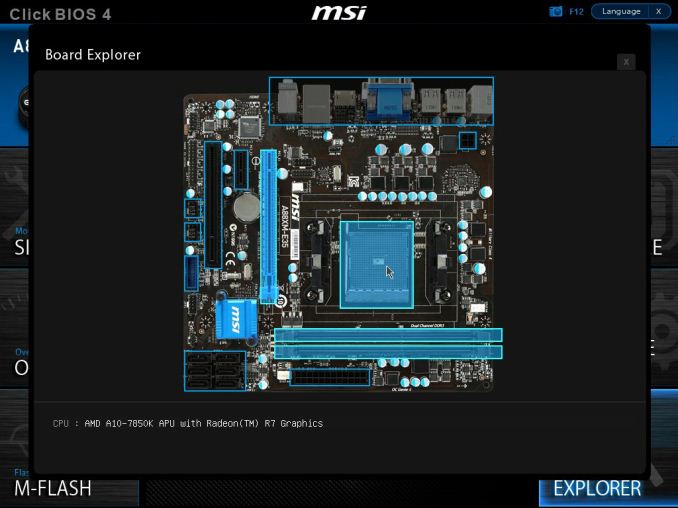














27 Comments
View All Comments
khanov - Thursday, April 3, 2014 - link
Also, PS/2 is interrupt-driven, USB requires the CPU to poll the ports. The effect of polling is to use/waste CPU cycles checking if the mouse has moved or a key has been pressed.Interrupt-driven I/O is superior, as it does not waste CPU cycles. The CPU only services the interrupt handler (keyboard/mouse code) when you press a key or move the mouse.
It may be 2014, but PS/2 is a better way to connect both mouse and keyboard than USB. I wish all vendors put both PS/2 ports on all motherboards.
frewster - Friday, April 4, 2014 - link
I seriously doubt any computer from this decade or even the past decade is noticeably slowed down by polling the USB ports.boot318 - Friday, April 4, 2014 - link
I agree. He should just state that he wants the connections, because otherwise, they should be dead.Powerlurker - Friday, April 4, 2014 - link
My assumption is that PS2 ports are still used in industrial computing. They are also a little bit cheaper. Last I checked, HP would cut about $5 or so off the price if you went with a PS2 keyboard over USB. If you're a corporate purchasing agent buying 1000 systems, that's an nontrivial amount of cash with practically no downside.dananski - Friday, April 4, 2014 - link
N-key rollover is why I'd want ps2, but more likely it's that if they're buying a budget board, they might be reusing a really old keyboard.sfuzzz - Tuesday, April 8, 2014 - link
It was an half-joke. No, I think the real reasons are that the PS/2 controller is integrated and fully functional on all chipsets and PS/2 keyboards are guaranteed to always work, especially on BIOS. Call it a failsafe solutionVoldenuit - Thursday, April 3, 2014 - link
Thank you for reviewing a motherboard with a price that's not 3-digits, Ian!LucinaHSacco - Thursday, April 3, 2014 - link
So how about an AMD Kaveri-supporting A88X motherboard priced at just £40? That would surely get some attention, right? The MSI A88XM-E35 is that board and we have it under the spotlight today. http://is.gd/mGuvSUSquattingDog - Thursday, April 3, 2014 - link
Ian, it is "bear that in mind" eg to keep in mind, not "bare that in mind" (naked in mind?! Hate to nitpick but this is at least the second article on this site I've seen it in.Also as other commenters have mentioned what is going on with the overheating of the VRMs? Specific chips or revisions only if all new chips are causing this?
zodiacsoulmate - Thursday, April 3, 2014 - link
The first thing I noticed when taking the motherboard out of the anti-static bag was the lack of a power delivery heatsink.What heatsink is that???????????
Isn't it the little blue thing on the mobo?